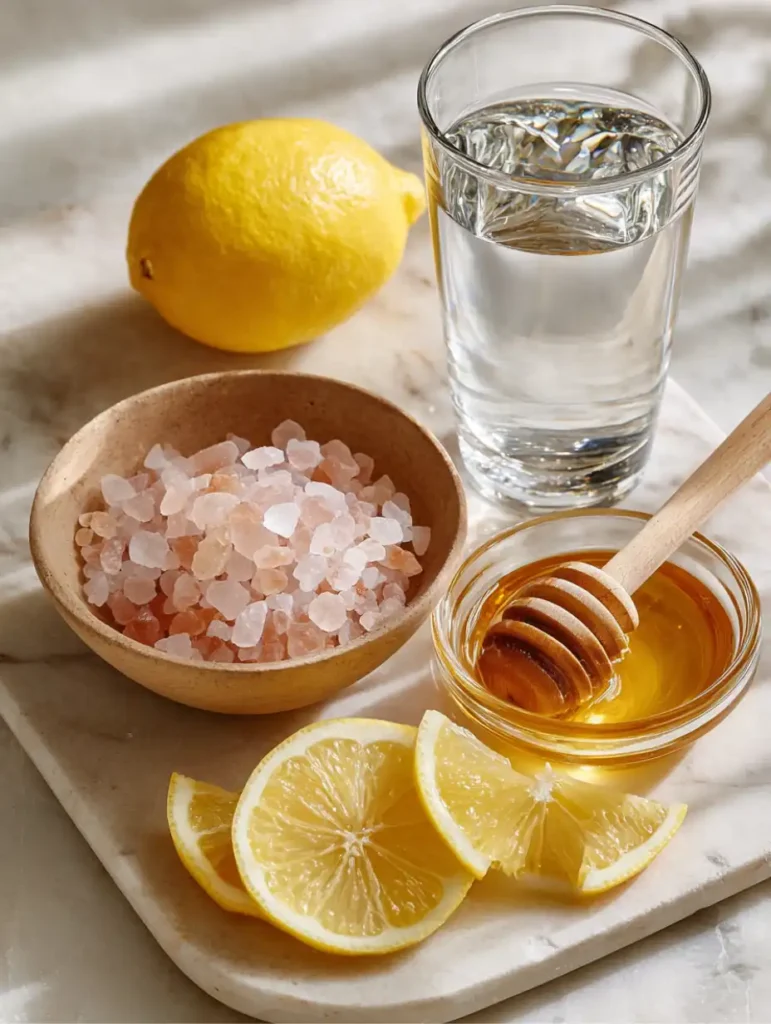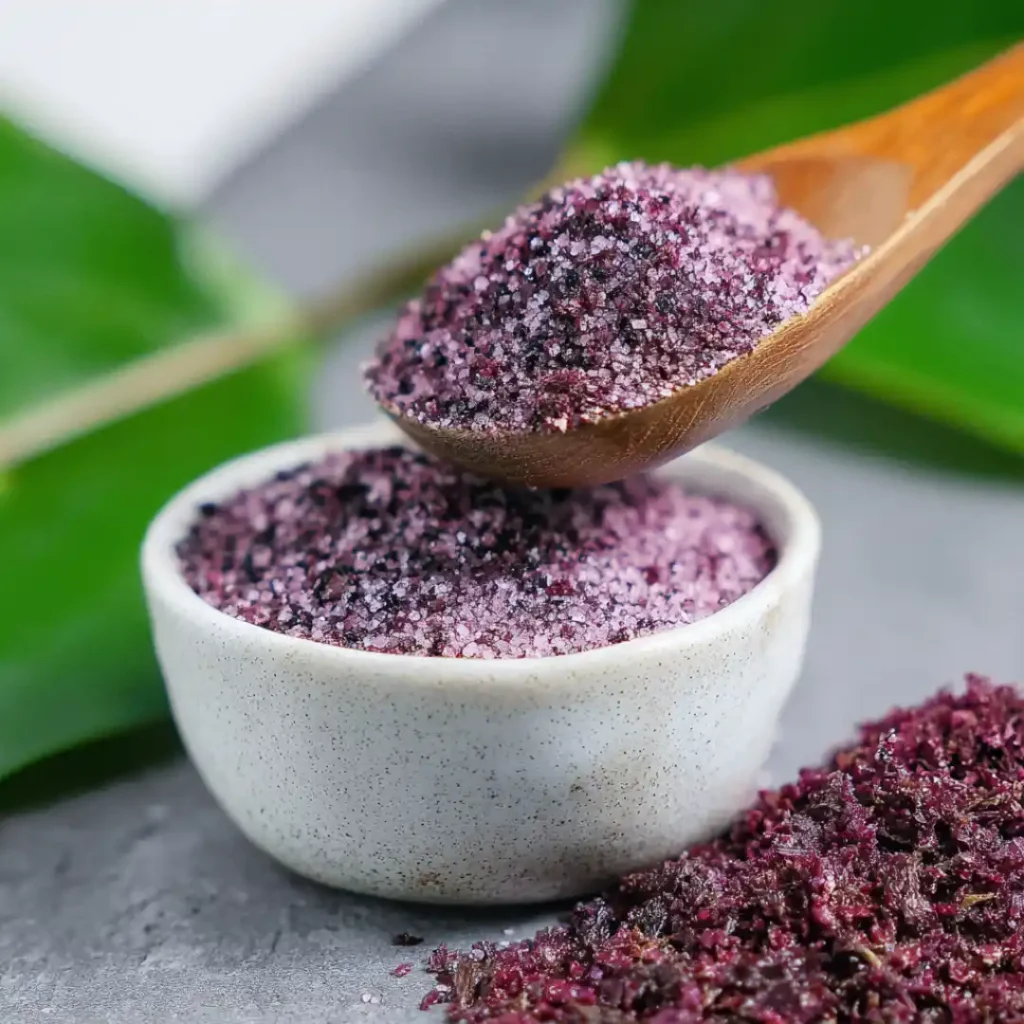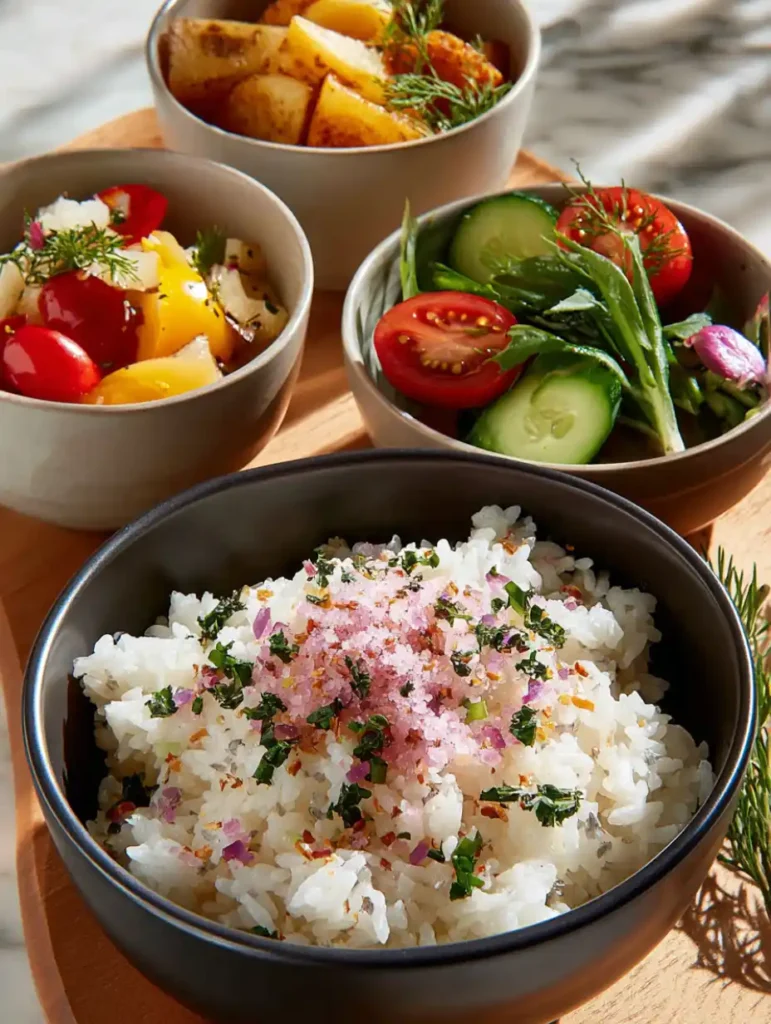Ever seen a Japanese pink salt recipe trending online and wondered if it’s just another fad? You’re not alone. Some people swear by a warm pink salt drink in the morning, while others think of a traditional Japanese seasoning made with red shiso leaves that gives rice and snacks a pink-purple hue.
Both are real, and both have their place in the kitchen. The drink version has gone viral on social media as a quick way to start the day, while the shiso salt version has been part of Japanese cooking for generations. By the end of this article, you’ll know what Japanese pink salt really means, how to make each type at home, and when to enjoy them safely.
What Japanese Pink Salt Means?
Two uses in home kitchens
Japanese pink salt is a phrase that gets used in two very different ways. Online, it usually points to a drink made with warm water, pink salt, and sometimes lemon or honey. In Japan, though, pink salt often refers to a seasoning mix made with red shiso leaves that turn the salt pink or purple. Both versions share the name but serve different purposes.
- The drink is simple: water plus a pinch of salt, sometimes with citrus or honey. It’s promoted as an electrolyte-style morning boost.
- The shiso salt (often called yukari when dried and ground) is sprinkled over rice, onigiri, or grilled foods. The color comes from red shiso leaves, which are also used to pickle plums (umeboshi).
Japanese sea salt vs Himalayan pink salt
Not all pink salt comes from the same source. Himalayan pink salt is mined in Pakistan, while Japanese cooks more often use sea salts harvested from the Pacific coast. If you want to stay true to Japanese kitchens, reach for a fine sea salt, then blend it with shiso or umeboshi powder to create a naturally pink seasoning.
Flavor, color, and when to use each
- The drink version tastes slightly salty with a bright hit of lemon if you add it. It’s more about hydration than flavor.
- The shiso version tastes herbaceous, tangy, and savory. It adds a pop of color and brightness to plain rice or light dishes.
Ingredients and Tools

For the drink version
- 2 cups filtered or spring water
- 1/4–1/2 teaspoon pink salt (Himalayan or fine Japanese sea salt)
- 1/2–1 teaspoon fresh lemon juice
- 1 teaspoon raw honey (optional)
These simple ingredients create a lightly flavored hydration drink. The key is balance, too much salt makes it unpleasant and raises sodium too high.
For shiso salt, yukari style
- Fresh red shiso leaves (or dried shiso if fresh isn’t available)
- Coarse or fine sea salt
- Optional: umeboshi powder or sakura petals for variations
The color and aroma come from the red shiso leaves, which release natural pigments.
Tools you need
- Saucepan (for blanching fresh shiso)
- Dehydrator or oven (to dry leaves fully)
- Mortar and pestle or spice grinder
- Fine mesh sieve
- Airtight jar for storage
A good grinder makes the difference between a rustic seasoning and a fine yukari powder.
How to Make Japanese Pink Salt Recipe
Exact ingredients and amounts
- 2 cups filtered or spring water
- 1/4–1/2 teaspoon Himalayan pink salt or Japanese sea salt
- 1/2–1 teaspoon fresh lemon juice
- 1 teaspoon raw honey, optional
Step-by-step method
- Heat the water until very warm, but not boiling. Let it rest for a minute.
- Stir in the pink salt until fully dissolved.
- Add lemon juice and honey, if you like, then stir again.
- Serve warm in the morning or pour over ice for a refreshing drink. Garnish with lemon slices or mint if desired.
Sodium per serving and who should skip
This drink delivers 200–500 mg of sodium per serving, depending on how much salt you use. That’s about 10–20% of the daily recommended limit for most adults. People with high blood pressure, kidney conditions, or those on a low-sodium diet should avoid drinking salted water regularly.
Flavor add-ins
- A few slices of fresh ginger
- A splash of apple cider vinegar
- A pinch of turmeric
- Extra honey for sweetness
Storage and prep tips
- Best enjoyed fresh, right after mixing.
- If you want it cold, prepare in advance and refrigerate for up to 12 hours.
- Shake or stir before drinking, as salt can settle.
Japanese Shiso Salt Recipe, Yukari Style

Ingredient list
- 1 cup fresh red shiso leaves (or 2–3 tablespoons dried shiso or yukari powder)
- 1/4 cup coarse or fine sea salt
- Optional: 1 teaspoon umeboshi powder or dried sakura petals for variations
Fresh shiso vs dried shiso
- Fresh shiso: Blanch quickly in boiling water, then pat dry. This helps release pigments and sets the color.
- Dried shiso or yukari: Already preserved and ready to grind with salt, making the process faster.
Drying options
- Dehydrator: Spread leaves evenly at 115–125°F (46–52°C). Dry for 4–6 hours until crisp.
- Oven: Set to the lowest temperature (usually 170–180°F / 75–80°C). Keep the door slightly open for airflow. Dry for 2–3 hours, checking often.
Grind, sift, and jar
- Once dry, crumble the leaves into small pieces.
- Use a mortar and pestle or spice grinder to create a fine powder.
- Mix with salt, tasting and adjusting ratios to your preference.
- Pass through a fine sieve for an even texture.
- Transfer to an airtight jar.
Uses
- Sprinkle over steamed rice or onigiri.
- Season grilled fish, tempura, or edamame.
- Mix into salad dressings or dipping sauces.
- Use as a cocktail rimming salt for a Japanese twist.
Storage and shelf life
- Store in an airtight jar in a cool, dark place.
- Best flavor within 2–3 months, though it keeps up to 6 months.
Japanese Pink Salt vs Himalayan and Sea Salt
Mineral profile at a glance
- Himalayan pink salt: Mined from ancient deposits in Pakistan. Contains trace minerals like iron oxide, which gives it the pink hue.
- Japanese sea salt: Harvested from Pacific seawater. Richer in magnesium, potassium, and calcium compared to mined salts.
- Shiso salt (yukari style): A blend of sea salt with dried red shiso, adding antioxidants, tannins, and herbal compounds unique to the leaf.
Taste and color differences
- Himalayan pink salt: Mild, slightly earthy flavor. Pale pink crystals.
- Japanese sea salt: Cleaner, sharper taste with a stronger salty punch. White to off-white crystals.
- Shiso salt: Tangy, herbal, and slightly fruity, with a pink or purple shade depending on leaf intensity.
Best matches for recipes
- Use Himalayan pink salt sparingly in drinks or as finishing salt for roasted meats.
- Use Japanese sea salt for everyday cooking, soups, or sushi rice.
- Use shiso salt for seasoning rice, fish, salads, or as a colorful garnish.
Substitutions and Variations
No shiso? Try umeboshi powder or sakura salt
If fresh or dried shiso is hard to find, you can swap in umeboshi powder (made from pickled plums) for a similar tangy kick. Another option is sakura salt, made with cherry blossom petals and sea salt, which adds a floral note.
Low-sodium tweaks for the drink
- Use just 1/8 teaspoon of salt per cup of water instead of 1/4–1/2 teaspoon.
- Add more lemon juice or honey to balance the flavor.
- Try using mineral drops in water as an alternative to heavy salt use.
Kid-friendly or athlete-focused options
- For kids: keep it light by skipping the salt and making it lemon water with a touch of honey.
- For athletes: add a pinch of baking soda (as some viral recipes suggest) for extra electrolytes, but only in small amounts, since too much can upset the stomach.
Nutrition and Safety Notes
Daily sodium limits
Most adults should stay under 2,300 mg of sodium per day, according to U.S. dietary guidelines. The pink salt drink can range from 200–500 mg in one serving, which already covers up to 20% of that daily limit.
Who should avoid the drink
- People with high blood pressure
- Anyone with kidney conditions
- Individuals on a low-sodium diet
- Children, unless adjusted with very minimal salt
For these groups, it’s best to stick with plain water or consult a healthcare professional before trying any salted drink.
Balanced hydration basics
Salt water isn’t the only way to hydrate. You can also use:
- Fresh fruit-infused water
- Unsweetened coconut water
- Homemade sports drinks with a measured mix of fruit juice, water, and a pinch of salt
The key is balance. While the drink may help replace electrolytes, overdoing salt can cause more harm than good.
Serving Ideas

Weeknight uses for shiso salt
Sprinkle shiso salt over steamed rice, onigiri, or soba noodles for an instant flavor lift. It gives a tangy, herbal taste that makes simple dishes more exciting.
Salad dressings and grilled items
Mix a teaspoon of shiso salt into salad dressings or sprinkle it over grilled fish, tofu, or roasted vegetables. The salt balances fatty flavors and adds a pop of color.
Cocktail rim and snack mixes
Use shiso salt to rim glasses for sake cocktails, gin tonics, or margaritas. You can also toss it into a snack mix with nuts, pretzels, and sesame seeds for a Japanese twist.

Japanese Pink Salt Recipe Powerful Shiso Flavor
Equipment
- Saucepan
- Dehydrator or oven
- Mortar and pestle or spice grinder
- Fine-Mesh Sieve
- Airtight jar
Ingredients
Shiso Salt (Yukari Style)
- 2 cups filtered or spring water
- 1/4–1/2 teaspoon Himalayan pink salt or fine Japanese sea salt start with 1/4 tsp per 12 oz
- 1/2–1 teaspoon fresh lemon juice
- 1 teaspoon raw honey (optional)
Shiso Salt (Yukari Style)
- 1 cup fresh red shiso leaves (or 2–3 Tbsp dried shiso/yukari powder) fresh needs blanching & drying
- 1/4 cup coarse or fine sea salt
- 1 teaspoon umeboshi powder or dried sakura petals (optional) variation
Instructions
- Heat water until very warm, not boiling; let rest 1 minute.
- Stir in pink salt until fully dissolved.
- Add lemon juice and honey (if using); stir again.
- Serve warm or over ice. Optional: garnish with lemon or mint.
- For shiso salt with fresh leaves: blanch leaves briefly, pat dry.
- Dry leaves in a dehydrator at 115–125°F (46–52°C) for 4–6 hrs, or in an oven at the lowest setting 2–3 hrs with door slightly open, until crisp.
- Crumble, then grind shiso into a fine powder; mix with sea salt (and optional umeboshi/sakura). Adjust ratio to taste.
- Sieve for an even texture and store in an airtight jar.
- Use shiso salt on rice, onigiri, grilled fish, tofu, vegetables, or as a cocktail rimming salt.
Video
Notes
Nutrition
Conclusion
Japanese pink salt can mean two very different things, and now you know both. The drink version is quick to make, refreshing, and best used in moderation. The shiso salt version connects directly to Japanese cooking traditions, adding color and tangy flavor to everyday dishes.
Whether you try the morning drink or make a jar of homemade shiso salt, the key is balance. Enjoy the taste, stay mindful of sodium, and don’t be afraid to experiment with different uses, from simple rice bowls to creative cocktails.
So, which version are you going to try first, the quick sip or the seasoning jar?
Frequently Asked Questions
1. What is Japanese pink salt, and is it different from Himalayan pink salt?
Yes. Himalayan pink salt is mined in Pakistan, while Japanese pink salt usually refers to either sea salt mixed with shiso (giving it a pink hue) or the viral pink salt drink.
2. How much pink salt should I add per 12 ounces of water?
Start with 1/4 teaspoon per 12 ounces. That gives enough sodium without going overboard.
3. Is the pink salt drink safe to have every day?
Not for everyone. It’s safe for healthy adults in moderation, but those with high blood pressure, kidney problems, or on sodium-restricted diets should avoid daily use.
4. Who should avoid the pink salt drink, such as people with high blood pressure?
Yes, anyone with high blood pressure, kidney disease, or children should skip it. Too much sodium can stress the body.
5. How do I make a red shiso salt seasoning at home?
Dry red shiso leaves, grind them, and mix with sea salt. The result is a pink-purple seasoning often called yukari.
6. Can I use dried shiso or yukari if I cannot find fresh shiso?
Yes. Dried shiso or yukari powder works well and saves time since you skip the drying step.
7. How should I store homemade shiso salt, and how long does it last?
Keep it in an airtight jar in a cool, dark place. For the best flavor, use within 2–3 months, though it can last up to 6 months.












Thank You